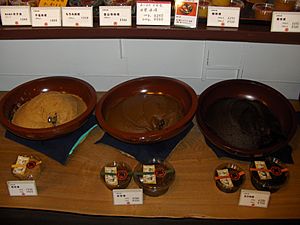Miso facts for kids
Miso (味噌 or みそ) is a thick, salty paste. It is a very old and traditional Japanese seasoning.
Miso is a bit like doenjang from Korea. It is made by fermenting soybeans with salt and a special mold called kōji. Kōji is made by growing a mold (Aspergillus oryzae) on rice, barley, or soybeans. Sometimes, other grains are added too. Miso is good for you because it has a lot of protein, vitamins, and minerals. It tastes salty, and some kinds can also be sweet, depending on how long they are fermented and what grains are used. Miso is most famous for being used to make miso soup.
Miso is a super important part of Japanese food. There are many different kinds of miso. Kome miso (米味噌) is made from rice and beans. Mame miso (豆味噌) is made mostly from beans. Mugi miso (麦味噌) is made from barley and beans. Awase miso (合せ味噌) is a mix of these different misos.
The History of Miso
Miso first came to Japan from China or the Korean peninsula a long time ago. It came from an ancient Chinese fermented seasoning called jan (醤). Jan was mentioned in an old Chinese book called the Shurai.
Miso, or something like it, was used in Japan even during the Jomon era. In the Nara era, jan was found in a city called Heiankyo. People used miso to season porridge made of rice and vegetables. During the Sengoku period, miso became important as a preserved food.
Many Japanese families used to make miso at home. This was called Temae-miso. In the Muromachi era, miso was used to preserve food and as a seasoning. It was a key source of nutrients for soldiers. In the Edo era, factories started making miso in large amounts. Because of this, fewer people made Temae-miso at home. Today, the phrase "Temae-miso" is also used when someone is proud of something they did themselves.
There are many different flavors of miso, and they often depend on the region in Japan. Shiromiso (白味噌), which is white miso, is popular in the western Kansai region, especially in Kyoto. Akamiso (red miso) is popular in the eastern Kantō region or northern parts of Japan. Shinshumiso (信州味噌) became very popular after World War II. This is because it is made in large factories and sold in supermarkets all over Japan.
Images for kids
See also
 In Spanish: Miso para niños
In Spanish: Miso para niños




